Research Article Open Access
Patent Analysis on Bioremediation of Environmental Pollutants
| Shweta Saraswat* | |
| National Institute of Science, Communication and Information Resources (CSIR) 14, India | |
| Corresponding Author : | Shweta Saraswat National Institute of Science Communication and Information Resources (CSIR) 14, India Tel: +91-9412828867; +91-7409560853 E-mail: shwetasara@gmail.com |
| Received June 16, 2014; Accepted September 20, 2014; Published September 22, 2014 | |
| Citation: Saraswat S (2014) Patent Analysis on Bioremediation of Environmental Pollutants. J Bioremed Biodeg 5: 251. doi:10.4172/2155-6199.1000251 | |
| Copyright: © 2014 Saraswat S. This is an open-a ccess article distributed under the terms of the Creative Commons Attribution License, which permits unrestricted use, distribution, and reproduction in any medium, provided the original author and source are credited. | |
Related article at Pubmed Pubmed  Scholar Google Scholar Google |
|
Visit for more related articles at Journal of Bioremediation & Biodegradation
Abstract
The scientific literature published in peer reviewed journals is the limited source of information for most of the scientists and academicians. As neither all researches nor their technological strategies are published in papers, therefore, lots of information remains missing. The systematic patent analysis using authenticated patent database makes it possible to find out technological strategies adopted by potential researchers. In spite of that, the research gaps along with research directions in a particular research field can also be identified. The aim of present study was to analyze the patenting trends in bioremediation technologies for environmental pollutants. This analysis was based on various criteria i.e. patenting trend over time, country-wise and assignee-wise comparisons and types of technology used in various patents. The Delphion database was used to retrieve bioremediation patents filed during 1990 to 2013. Out of 443 patents, United States accounted for maximum patent publications, followed by China, Japan, Korea, India etc. Yearly analysis revealed that maximum (35) patents were published in 2005. Out of 31 patent assignees, the United States Secretary of Agriculture obtained maximum patents followed by Exxon Research and Engineering Co. Comparison among technological groups indicated that maximum patents (33%) were associated with technologies for reclamation of contaminated soil followed by wastewater and sewage treatment technologies (22%) and use of micro-organisms (20%) natural as well as genetically engineered for bioremediation of environmental pollutants. Further, identification of process/product based utility of screened patents revealed that 80% patents were directed towards processes of bioremediation while 20% were products for assisting bioremediation.
| Keywords |
| Patent analysis; Bioremediation; Phytoremediation; Phytoextraction; Environmental pollutants |
| Introduction |
| To meet the world’s growing needs; global industrial revolution has contributed in polluting the environment by producing extremely toxic chemical and biological wastes in bulk. To protect the environment from existing pollutants, there is a need to promote innovation in pollution abatement technologies. After various international environmental agreements, governments of different countries have focused on green product and process innovations to minimize environmental risk, but there has been little interest in developing eco-friendly technologies for removing the environmental pollutants. Considering this, bioremediation has now been emerged as a technological advancement to decontaminate the polluted sites either aquatic or terrestrial, in an effective, eco-friendly manner without generating secondary wastes. Bioremediation involves naturally occurring organisms to break down or neutralize inorganic and organic pollutants into less toxic or nontoxic forms. Some examples of bioremediation related technologies are phytoremediation, rhizofilteration, bioaugmentation, biostimulation, landfarming, bioreactor, and composting. As a part of bioremediation, Phytoremediation employs metal accumulating plants for removing toxic wastes via absorption, adsorption and extraction of contaminants from water and soil [1,2]. Thus, better environmental protection can be achieved by promoting eco-innovative bioremediation technologies. |
| Patent analysis of bioremediation could assist the scientists, stakeholders (technologists, business leaders, attorneys, etc.), policy planners and researchers to access technology updates, develop new process and product, plan future research strategies and take key decisions for developing R&D investment plans for more economic and environmental gain. Earlier workers also measured environmentally motivated innovations, such as pollution control technologies and green energy technologies, and for general purpose technologies with environmental benefits. Lanjouw and Mody [3] counted the number of patents in nine environmental fields (viz. Industrial air pollution, water pollution, vehicle air pollution, solid waste, incineration of waste, alternative energy, oil spills, radioactive waste and recycling and reusing waste), Nameroff et al. [4] studied green chemistry patents, Johnstone [5] analysed renewable energy patents, and Sun et al. [6] studied the pattern of environmental patents by ownership in China. Since, patents are the best measure of innovative activities, therefore the objectives of present study were (i) to analyse overall patent activity in the field of bioremediation, (ii) to assess global distribution of bioremediation patents, their patenting trend over time and assignees, (iii) to identify potential areas for future research and development in bioremediation technologies. |
| Methodology |
| Patent databases searched |
| The relevant patents in the context of bioremediation were retrieved from different databases on the basis of priority of filing during 1990 to 2013. The databases searched included publicly available e.g. USPTO, EPO, SURFIP, WIPO and FREEPATENTSONLINE and subscription based database Delphion . Delphion is an authenticated databases which covered United States Patents - Applications (US), United States Patents - Granted (US), Derwent World Patents Index (DWPI), European Patents - Applications (EP-A), European Patents - Granted (EP-B), German Patents - Applications, German Patents - Granted, INPADOC Family and Legal Status, Patent Abstracts of Japan, Switzerland and WIPO PCT Publications. As Delphion do not cover Indian Patent data of granted and filed patent application, therefore, the Indian patents on bioremediation were retrieved from Indian Patent Information Retrieval system separately. |
| Search strategy and analysis |
| To search patent publications in the field of bioremediation, the methodology was mainly based on appropriate keyword searches in title, abstract and claims fields of all patents available in different databases. The search algorithm for parent string was used as: (“Bioremediation” or “Phytoremediation” or “Phytoextraction”) AND (“Plant” or “bacteria” or “fungal” or “microorganism”). A total of 627 patent documents were retrieved. The abstract of each single patent was scrutinized in order to determine relevancy of patent. The irrelevant patents, not related to bioremediation technologies, were eliminated. This step was undertaken to avoid the potential error of having unrelated patents, thereby improving the quality of searched patent data set. Finally, 443 patent documents were screened according to their relevance. The retrieved data was stored in a MS-Excel worksheet, analysed and interpreted in order to understand geographical distribution of patents, patenting trend over time and major assignees that holds proprietary rights. The patent data have been segregated primarily into five sectors comprising (i) Government (ii) Corporate (comprising industrial organizations and corporate bodies), (iii) Academic (comprising Academic Institutes and Universities), (iv) Institutional (comprising Research Institutes), and (v) Individuals (comprising individual or group of individuals). The screened bioremediation patents were also classified as per International Patent Classification (IPC) based on their technology areas and utility. |
| Results and Discussion |
| Geographical distribution of patents |
| Patents are the indicator of country’s economic growth [7] and patenting activities across the countries transfer and disseminate the technology contained in the patent [8]. Among top five countries, United States (US) was the forerunner sharing 61.85% patents in bioremediation technologies followed by China (7.9%), Japan (6.77%), Korea (4.51%) and India (2.93%) (Figure 1). The other countries viz. Spain, Canada, Australia, France, Belgium, Great Britain, Russia, Germany, Brazil, Chile were less active in bioremediation research. Out of 443 patents, 67% were filed by North American countries, 23% by Asian countries and 10% by European countries. There was a large gap in technological position of US and European countries. Even, Asian countries filed more patents (2 times) than European countries. The recent report suggested that the counties with the largest R&D expenditure are the US>UK>France>Germany>Japan>China>Korea [9]. The case was not the same in present study. The Asian countries filed more patents indicating more investment on R&D. The position of European countries was declined in patenting activity which may possibly due to less investment in R&D related of bioremediation technologies. China emerged as the world’s second patent holder behind the US, which certainly be due to increasing its R&D spends even more than Russia, Britain, Germany, France and Italy combined. Although, other Asian countries particularly Japan and Korea are also rapidly increasing their R&D spends to become technologically strong by more patent filings. Although, highest innovative research in US might be due to having more scientific manpower, improved research facilities, infrastructure and financial resources [10]. As the patent protected technologies are too costly, therefore, government of developed nations should make provisions to disseminate such technologies to poor nations who are far behind in contributing scientific research due to inadequate infrastructure, less funding resources and high cost of importing scientific equipments. |
| Patenting trend over time |
| The results of patenting activity in the field of bioremediation revealed that maximum patents (35) were published in 2005 owing to more R&D activities (Figure 2). As such, the patenting activity was increased sharply since 1990 till 2005, which decreased gradually up to 2012. During 2002-2005, the patenting activities were high indicating that the activity has been very recent and this field has gained importance in recent years. Also, there might be more financial investment in R&D of bioremediation technologies during that period. However, before 1994, there was little patent activity in this field |
| Assignees of bioremediation patents |
| There were 31 assignees active in research related to bioremediation (Figure 3). The United States Secretary of Agriculture (USSA) got maximum number of patents followed by Exxon Research & Engineering Co. and University of Georgia Research Foundation, Inc, Regents of the University of California and Geovation Technologies, Inc. The USSA obtained patents on hyperaccumulating plant species capable of removing or recovering heavy metals from contaminated soils along with the processes for degrading and/or bioremediating waste wood containing organic and inorganic contaminants i.e. chromated copper arsenate (CCA), creosote and pentachlorophenol using a fungal inoculum. Exxon Research & Engineering Co. invented surfactant system for bioremediation of hydrocarbon contaminated soils and water that increases the interface between the hydrocarbon contaminant, microbial nutrients and microflora, and also stimulates the propagation of the microflora, thereby enhancing microbial degradation of the hydrocarbon contaminant. Georgia Research Foundation, Inc. developed process for producing metal resistant transgenic plants using recombinant DNA comprising a nucleic acid sequence encoding a metal ion resistance protein leading to enzymatic reduction of metal ions. The invention also involves a method of phytoremediation of a contaminated site by growing in the site a transgenic plant expressing a nucleic acid encoding a metal ion reductase and a nucleic acid encoding a phytochelatin biosynthetic enzyme. The Regents of University of California also developed method and compositions for enhancing heavy metal phytoremediation of metal contaminated soils or waters employing genetically engineered plant (Brassicaceae family) comprising a gene encoding glutamylcysteine synthetase leading to enhanced heavy metal accumulation. They also invented a system for in-situ field water remediation using microbial filter. Geovation Technologies, Inc. got patents on solid and liquid chemical compositions for anaerobic biodegradation, detoxification, and transformation of toxic organic and inorganic compounds present in solid and liquid wastes, soils, sediments, and water bodies. The patent involves improved means of (i) promoting the solid-liquid phase extraction and absorption of recalcitrant contaminants from contaminated media, (ii) creating, enhancing, and maintaining anaerobic conditions (i.e., negative redox potential), (iii) providing a source of carbonaceous cosubstrates, anaerobic electron acceptors, and nutrient to promote the growth of contaminant-degrading microorganisms, and (iv) providing sources of inoculum of naturally occurring microorganisms which act to promote the biodegradation of contaminants. |
| Further, the evaluation of technological competencies of different assignees in the field of bioremediation revealed that maximum patents were filed by corporate sector, while government organizations and institutes showed least interests in patenting activity globally (Figure 4). Even in India, the government organizations were less active towards innovative R&D in bioremediation technologies (Figure 5). In India, government organizations viz. Council of Scientific and Industrial Research and Indian Council of Agricultural Research got 2 patents, whereas corporate sector viz. Bharat Petroleum Corporation Ltd. Indian Oil Corporation Ltd., and M/S Avestha Gengraine Technologies Pvt. Ltd. got 4 patents. Even individual assignees got more patents than government organizations within India. As the individuals are the catalyst and growth centre of every country, therefore government should promote such individuals and groups for developing eco-innovative pollution remediation technologies to leverage environmental protection. The environmental pollution is global issues and has no political boundaries, therefore, government of both developed and developing nations should make efforts for finding ecofriendly solution of pollution and international diffusion and transfer of bioremediation technologies in order to reduce their toxic wastes and contribute in global environmental protection. |
| Technology based classification of bioremediation patents |
| According to IPC, the bioremediation patents were categorized into various technological groups (Figure 6). The maximum (265) patents were covered under B09C followed by C02F (174) and C12N (160). Comparatively, there was less patent in other technology areas viz. A01H, A62D, B09B, C22B, C12P, A01N and A01G (Figure 6). The subclass B09C covers technologies related to reclamation of contaminated soil, however, C02F covers water treatment technologies, and C12N covers micro-organisms or enzymes and technologies for mutation or genetic engineering. The description of each subclass and associated groups along with patent counts are given in Table 1. Also, identification of process/product based utility of screened patents revealed that B09C, C02F, A01H, A62D, B09B, C22B, C12P, A01N and A01G represented process patents while C12N represented product patent, indicating that most of the patents were directed towards processes of bioremediation. Thus, there is a need to give more attention on product based bioremediation technologies employing microbes and enzymes degrading and/or detoxifying hazardous substances present in environment. The IPC results also demonstrated that bioremediation technologies for contaminated water are also available scarcely; therefore, attention should be given in this direction also. As such, the IPC mapping of bioremediation technologies could provide immense help to scientists, technologists, decision makers and researchers to plan future research strategies and R&D investment in thrust areas for more economic and environmental benefits. |
| Conclusion |
| The study concluded that number of patent applications in bioremediation domain is very less. The United States Secretary of Agriculture exhibited maximum patents. After US, China and Japan had strong patent activity. Most of the patents were directed towards processes for reclamation of contaminated soils using micro-organisms or enzymes. Comparatively, technologies for biological treatment of wastewater are less. The patents on genetically engineered microorganisms and plants producing more metal chelating compounds e.g. phytosiderophores, phytochelatins and metallothioneins, and nucleic acid sequences encoding multimetal resistance protein are also reduced in number. Very few patents are available on production of metal hyperaccumulating plants by tissue culture techniques. Also, patents on processes for metal recovery using micro-organisms or enzymes are scarce. These identified research gaps in the field of bioremediation bring out a scope for generating intellectual property. Further, development of products (nucleic acid sequences, metal chelating agents, transgenic plants and micro-organisms) for removing and/or recovering harmful substances from the terrestrial and aquatic environment at a faster rate even in extreme environments could certainly ensure economic and environmental protection as well. |
| Acknowledgements |
| I gratefully acknowledge TIFAC (Technology Information, Forecasting and Assessment Council), Department of Science & Technology, Govt. of India, for providing research fellowship in the form of Women Scientist Scheme C (WOS-C). I would also thank NISCAIR (National Institute of Science, Communication and Information Resources) for providing authenticated patent database to perform patent searching and retrieving the data. |
References
|
Tables and Figures at a glance
| Table 1 |
Figures at a glance
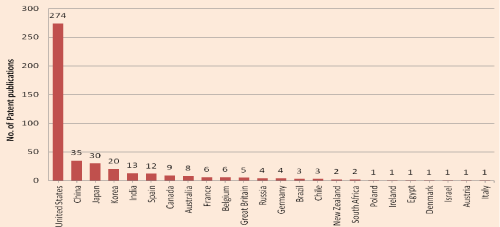 |
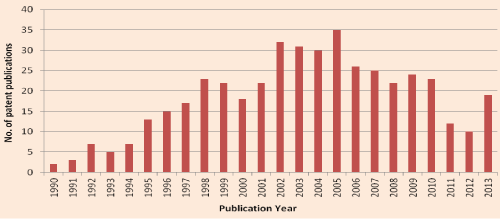 |
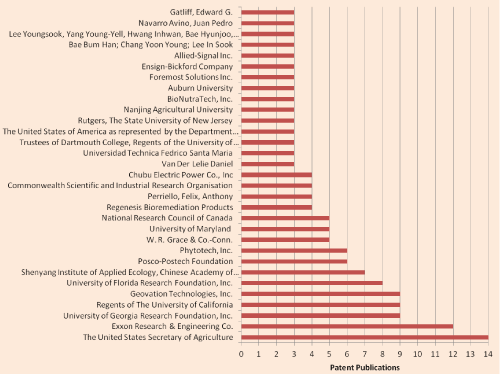 |
| Figure 1 | Figure 2 | Figure 3 |
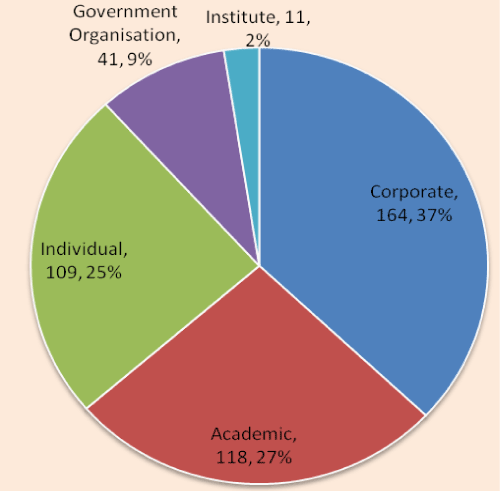 |
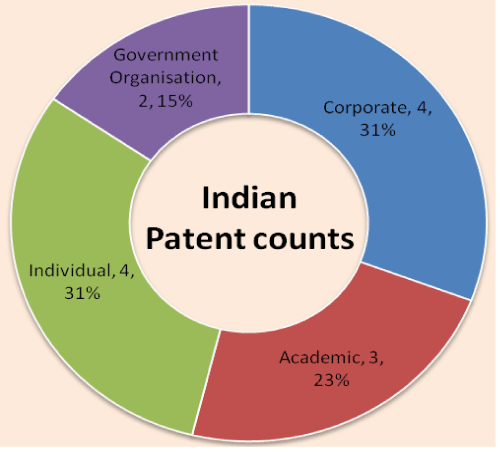 |
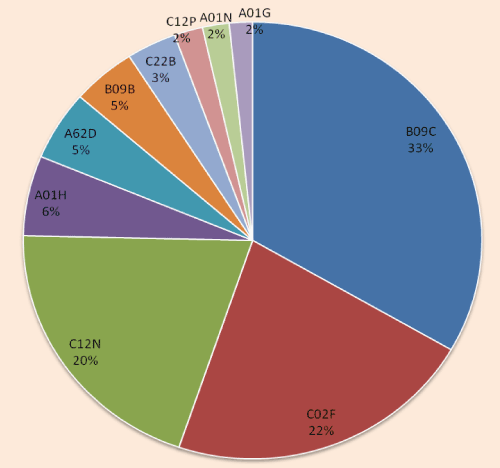 |
| Figure 4 | Figure 5 | Figure 6 |
Relevant Topics
- Anaerobic Biodegradation
- Biodegradable Balloons
- Biodegradable Confetti
- Biodegradable Diapers
- Biodegradable Plastics
- Biodegradable Sunscreen
- Biodegradation
- Bioremediation Bacteria
- Bioremediation Oil Spills
- Bioremediation Plants
- Bioremediation Products
- Ex Situ Bioremediation
- Heavy Metal Bioremediation
- In Situ Bioremediation
- Mycoremediation
- Non Biodegradable
- Phytoremediation
- Sewage Water Treatment
- Soil Bioremediation
- Types of Upwelling
- Waste Degredation
- Xenobiotics
Recommended Journals
Article Tools
Article Usage
- Total views: 17309
- [From(publication date):
November-2014 - Apr 02, 2025] - Breakdown by view type
- HTML page views : 12586
- PDF downloads : 4723
